大十二面截半二十面体
 | ||||
| 类别 | 均匀星形多面体 | |||
|---|---|---|---|---|
| 对偶多面体 | 大十二角星化六十面体 | |||
| 识别 | ||||
| 名称 | 大十二面截半二十面体 Great dodecicosidodecahedron | |||
| 参考索引 | U61, C77, W99 | |||
| 鲍尔斯缩写 | gaddid[4] | |||
| 数学表示法 | ||||
| 考克斯特符号 | ||||
| 威佐夫符号 | 5⁄2 3 | 5⁄3[2][3] 5⁄3 3⁄2 | 5⁄3 | |||
| 性质 | ||||
| 面 | 44 | |||
| 边 | 120 | |||
| 顶点 | 60 | |||
| 欧拉特征数 | F=44, E=120, V=60 (χ=-16) | |||
| 组成与布局 | ||||
| 面的种类 | 20个正三角形 12个正五角星 12个正十角星 | |||
| 顶点图 | [5/2,10/3,3,10/3] | |||
| 对称性 | ||||
| 对称群 | Ih, [5,3], *532 | |||
| 图像 | ||||
| ||||
在几何学中,大十二面截半二十面体是一种由正三角形、正五角星和正十角星组成的星形均匀多面体,其索引为U61[5],是大十二角星化六十面体的对偶多面体[6],具有二十面体群对称性。[7][8]外观上在每个十角星面上呈现出浮雕状的五角星,每个浮雕状的五角星上面都有一个平行于十角星面的五角星面[9]:154,因此这个立体中正五角星面和正十角星面的数量相同,皆为12个[10]。 由于这个立体皆由正多边形面所组成,因此有时也被归类于星形阿基米德立体[11]。
性质
[编辑]大十二面截半二十面体共由44个面、120条边和60个顶点组成。[12]在其44个面中,有20个正三角形面、12个正五角星面和12个正十角星面。[12]其60个顶点每个顶点都是2个十角星、1个三角形和1个五角星的公共顶点,并且这些面在顶都周围皆是依照五角星、十角星、三角形、十角星的顺序排列,在顶点图中可以用[5/2,10/3,3,10/3][4][10]或{10/3, 5/2, 10/3, 3}[7]来表示。若将大十二面截半二十面体作为一个简单多面体,也就是将自相交的部分分离开来,则这个立体会有180个外部面[13] ,分别由三种部件组成,每种部件各有60个。[9]:154[14]
表示法
[编辑]大十二面截半二十面体在考克斯特—迪肯符号中可以表示为![]()
![]()
![]()
![]() (x5⁄3x5⁄2o3*a)或
(x5⁄3x5⁄2o3*a)或![]()
![]()
![]()
![]() (x3⁄2o5⁄3x5⁄3*a)[1]。在威佐夫记号中可以表示为5⁄2 3 | 5⁄3[2][3]。
(x3⁄2o5⁄3x5⁄3*a)[1]。在威佐夫记号中可以表示为5⁄2 3 | 5⁄3[2][3]。
尺寸
[编辑]令大十二面截半二十面体边长为单位长,则其外接球半径为:[12][4]
二面角
[编辑]大十二面截半二十面体共有两种二面角,分别为十角星面与三角形面的二面角以及十角星面与五角角面的二面角。[12][4]
其中,十角星面与三角形面的二面角约为100.8123度:[4]
十角星面与五角角面的二面角约为116.565度:[4]
分类
[编辑]由于大十二面截半二十面体的顶点图为梯形且具备点可递的特性,同时,其存在自相交的面,因此大十二面截半二十面体是一种自相交拟拟正多面体(Self-Intersecting Quasi-Quasi-Regular Polyhedra)。自相交拟拟正多面体一共有12种[15],除了小双三角十二面截半二十面体外,其余由阿尔伯特·巴杜罗(Albert Badoureau)于1881年发现并描述。[16]
 小立方立方八面体 |
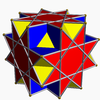 大立方截半立方体 |
 非凸大斜方截半立方体 |
 小十二面截半二十面体 |
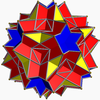 大十二面截半二十面体 |
 小双三角十二面截半二十面体 |
 大双三角十二面截半二十面体 |
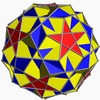 二十面化截半大十二面体 |
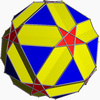 小二十面化截半二十面体 |
 大二十面化截半二十面体 |
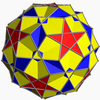 斜方截半大十二面体 |
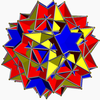 非凸大斜方截半二十面体 |
相关多面体
[编辑]大十二面截半二十面体与截角大十二面体以及6和12复合五角柱共用相同的顶点布局。同时,其亦与非凸大斜方截半二十面体和大斜方十二面体共用相同的边布局。[4]
 非凸大斜方截半二十面体 |
 大十二面截半二十面体 |
 大斜方十二面体 |
 截角大十二面体 |
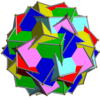 六复合五角柱 |
 十二复合五角柱 |
参见
[编辑]参考文献
[编辑]- ^ 1.0 1.1 Richard Klitzing. Icosahedral Symmetries uniform polyhedra, Polytopes & their Incidence Matrices. bendwavy.org. [2022-08-07]. (原始内容存档于2018-07-07).
- ^ 2.0 2.1 George W. Hart. Uniform Polyhedra. 1996 [2022-08-07]. (原始内容存档于2018-09-19).
- ^ 3.0 3.1 V.Bulatov. great dodecicosidodecahedron. [2022-08-07]. (原始内容存档于2021-02-28).
- ^ 4.0 4.1 4.2 4.3 4.4 4.5 4.6 Richard Klitzing. gaddid, great dodekicosidodecahedron. bendwavy.org. [2022-08-07]. (原始内容存档于2022-08-17).
- ^ Weisstein, Eric W. (编). Great Dodecicosidodecahedron. at MathWorld--A Wolfram Web Resource. Wolfram Research, Inc. (英语).
- ^ Eric W. Weisstein. Great Dodecicosidodecahedron. archive.lib.msu.edu. 1999-05-25 [2022-08-07]. (原始内容存档于2021-11-29).
- ^ 7.0 7.1 Maeder, Roman. 61: great dodecicosidodecahedron. MathConsult. [2022-08-07]. (原始内容存档于2022-05-25).
- ^ Zvi Har'El. Kaleido Data: Uniform Polyhedron #66. harel.org.il. [2022-08-07]. (原始内容存档于2022-08-07).
- ^ 9.0 9.1 Wenninger, M.J. Polyhedron Models. Cambridge University Press. 1974 [2021-09-05]. ISBN 9780521098595. LCCN 69010200. (原始内容存档于2021-08-31).
- ^ 10.0 10.1 The Great Dodecicosidodecahedron. polyhedra.mathmos.net. [2022-08-07]. (原始内容存档于2022-08-07).
- ^ stellated archimedians. polyhedra.mathmos.net. [2022-08-07]. (原始内容存档于2021-05-14).
- ^ 12.0 12.1 12.2 12.3 12.4 12.5 David I. McCooey. Self-Intersecting Quasi-Quasi-Regular Polyhedra: Great Dodecicosidodecahedron. [2022-08-07]. (原始内容存档于2018-03-31).
- ^ Robert Webb. Great dodecicosidodecahedron. software3d.com. [2022-08-07]. (原始内容存档于2022-08-07).
- ^ Great dodecicosidodecahedron. polyhedr.com. [2022-08-07]. (原始内容存档于2022-08-07).
- ^ David I. McCooey. Self-Intersecting Quasi-Quasi-Regular Polyhedra. [2022-08-07]. (原始内容存档于2022-08-22).
- ^ Jean Paul Albert Badoureau. Mémoire sur les Figures Isocèles. Journal de l'École polytechnique. 1881, (49): 47–172.






